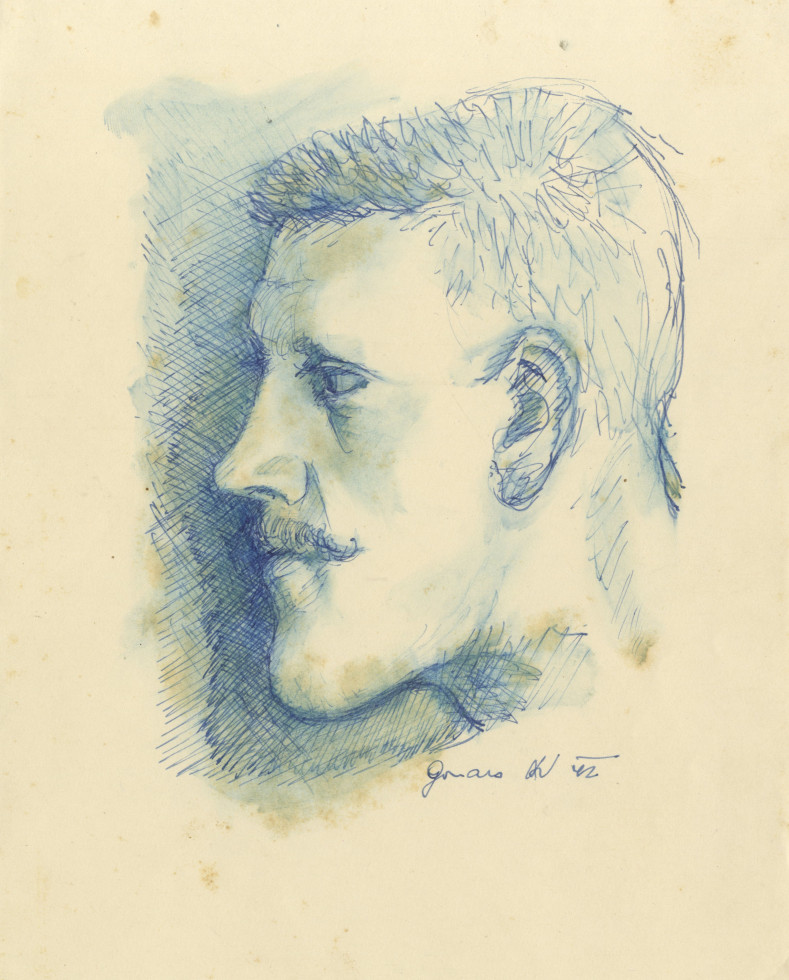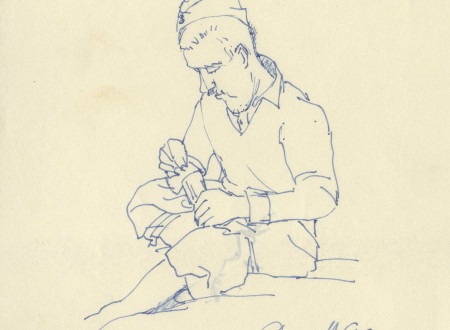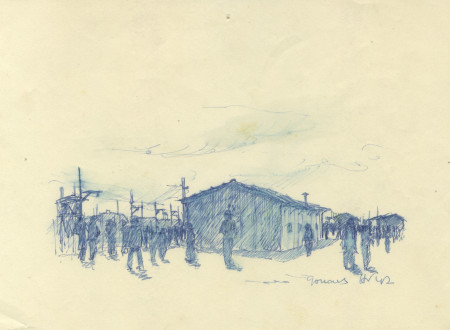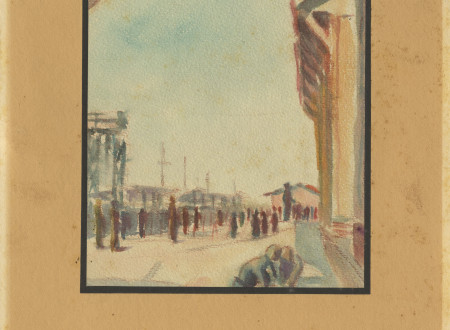Dr. Igor Breznik, His Faith and the Collection of Drawings from the Gonars Concentration Camp
In 2014, the Archives of the Republic of Slovenia received a donation which among other things included also part of the legacy of dr. Igor Breznik. In it there is a collection of drawings made at the Italian concentration camp in Gonars. The donation was made by Peter Breznik. Included in the collection are two watercolours and 21 drawings, all created at the concentration camp in 1942. The author of most of drawings and watercolours is Valentin Horvat, three of them were drawn by Otmar Dresle. The paintings were brought from the concentration camp to Ljubljana by Igor Breznik, who is depicted in nine drawings.
Igor Breznik was born on June 1, 1917 in Ljubljana. Having finished his grammar school, he enrolled in the faculty of law in 1936. He was a member of the »Ljubljana Sokol« gymnastic society, and worked out at the »Sokol society in Narodni dom« until 1940. He was also a member and one of the leaders of »Adriatic Guard (Jadranska straža)«. Later on he was among the leaders of the »Yugoslav National Academic Association Jugoslavia« as well, where in the autumn of 1938 he was elected president. In 1939, he was also among the leaders of the »Academic National Block«. In June 1940, he passed his bar exam and enrolled in the faculty of engineering. When the Kingdom of Yugoslavia joined the Tripartite Pact on March 25, 1941, Igor Breznik was actively involved in student protests held in Ljubljana. Following the coup d'état instigated by pro-British officers and the seizure of power by king Peter II, Breznik was among the leaders of manifestation held at the Congress Square on March 27, 1945 in support of the coup. When Yugoslavia was attacked by the Axis powers on April 8, 1941, he joined the others and formed an academic voluntary department and set out on the same day from the National Gallery in Ljubljana to Novo mesto. There they spent the night at the barracks and left for Zagreb the following day. However, since by that time the Ustasha came to power in Zagreb, Breznik and the others began to retreat north on April 10. The colony of returning volunteers was even attacked by a German plane. Since Germans were chasing the wandering Yugoslav soldiers, the volunteers had to make their retreat across the mountains. In late April 1941, Breznik began his internship at the Ljubljana District Court. Up until the autumn of 1941 he was a member of the illegal anti-fascist circle Liberation Front, but from then on he was only a member of the illegal part of the Sokol Legion, since in October 1941, the talks about the potential joining of the Sokol Legion to the Liberation Front, conducted between both parties, failed because the legion insisted on its loyalty to the king.
On March 15, 1942, Igor Breznik was arrested in a raid by the Italian police. According to the Sokol Legion, their members were given away by members of the Liberation Front. He was taken away to the concentration camp in Čignij and from there to the concentration camp in Gonars. He was there for six months. When he returned from Gonars he brought with him the mentioned drawings and pictures. He was deeply upset about the news that the partisans killed his friend Milan Gaberščik. Born in Krmin in 1918, Gaberščik was Igor's schoolfriend in grammar school. He was a lawyer and one of the leaders of the Yugoslav National Academic Association Jugoslavia. He was arrested in a raid by the Italians and was on board of the train for Gonars which was attacked by the partisans on the night of June 28, 1942: the partisans captured the internees on the train, and executed some of them, among them also Gaberščik. Upon his return from Gonars, Breznik and his brother Mark wanted to go »to the woods« in the summer of 1943; he acquired fake passes so that they could leave Ljubljana but changed his mind once he found out that in September 1943 the partisans attacked the Chetnik outpost in Grčarice, where there was also a number of the members of Sokol.
In February 1944, Breznik received the title of doctor of law at the Ljubljana University and started his internship at the Ljubljana post office in March of the same year. In August 1944, dr. Franc Jerovec, dr. Emil Namar and himself, all members of the Yugoslav National Academic Association Jugoslavia and the Sokol Legion, joined the Home Guard. He was to do that based on the decision by the leadership of the Sokol Legion in cooperation with the British intelligence service with a mission to infiltrate. Based on the order of the Gestapo, all three of them were immediately imprisoned by the Home Guard police. At first they were supposed to be sent to Dachau, but were after the interrogation on September 15, 1944 finally assigned to Home Guard military units. Breznik was assigned as a clerk and an investigative judge to the Home Guard battalion in Cerknica, where he was in charge of civil offenses of Home Guard soldiers. He returned to Ljubljana on weekends and by the end of April 1945 he remained in Ljubljana and did not return to Cerknica. At the beginning of May 1945 he made a red star out of cloth and helped his mother to sew it on the Slovenian flag which he then displayed at his home on May 9, 1945.
Upon several calls to »all members of the former military units« to appear before the newly established authorities, Igor Breznik showed up at the headquarters of the city of Ljubljana in his civilian clothes on May 13, 1945. From there he was taken to the prison of the Department of National Security which at the time was located on the premises of the present day St. Stanislav's Institution and its surroundings in Šentvid near Ljubljana. From that moment on no one received any word from him and no official report on him can be found. He was probably murdered at Brezarjevo brezno in Podutik. Later there was also an inquiry into his faith conducted by the British.
In April 1981, there was an opening of the exhibition at the Cankarjev dom in celebration of the 40th anniversary of the founding of the Liberation Front titled »Liberation Front in Ljubljana – a State Within a State«. Depicted in a large photo in the front was dr. Igor Breznik accompanied by two students. The photo was taken in April 1941 just before the students volunteers left for Novo mesto.
Matevž Košir





